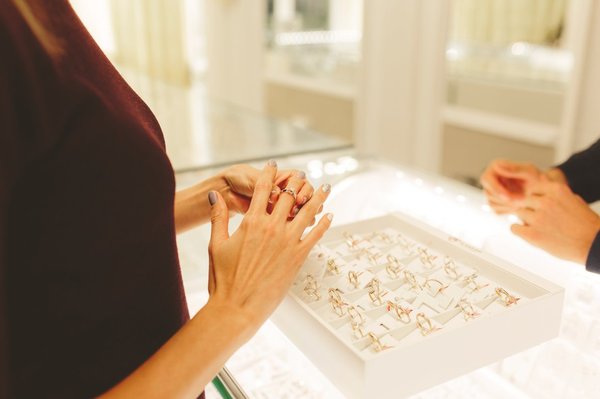You may not be able to define luxury, but chances are good that you know it when you see it. Luxury goods are the opposite of necessities. They're high-end products that consumers want but don't need. They're also distinct from commodity products (such as bananas or gasoline) that are not easily distinguished by brand.
Luxury goods are more expensive than competing products because they are perceived as higher-quality and confer status on the owner. Because of that relationship, brand is a crucial component of a luxury stock. Luxury stocks are publicly traded companies that sell luxury goods, which could be anything from cars to cosmetics to fashion to furniture.
The best luxury stocks have strong brands, high operating margins, and timeless products.

As non-necessities, luxury goods resemble high-priced discretionary goods, making them the opposite of consumer staples, or everyday products, such as groceries, that consumers buy because they need them. Although luxury goods may sometimes be durable goods, such as cars, they can also be consumables -- cosmetics or cigars, for example.
Investors most often think of retail products when they think of luxury. Those may include fashion from brands such as Burberry Group (BURBY 0.71%), Jimmy Choo, which is owned by Capri Holdings (CPRI 1.34%), or Stuart Weitzman, which belongs to Tapestry (TPR -0.55%). However, the sector goes beyond retail to include travel, food and dining, and even services.
Best luxury stocks to buy
Best luxury stocks to buy
The chart below shows five of the top luxury stocks you can buy this year.
| Name and ticker | Market cap | Dividend yield | Industry |
|---|---|---|---|
| RH (NYSE:RH) | $4 billion | 0.00% | Specialty Retail |
| LVMH Moët Hennessy - Louis Vuitton (OTC:LVMUY) | $322 billion | 2.20% | Textiles, Apparel and Luxury Goods |
| Ferrari (NYSE:RACE) | $89 billion | 0.68% | Automobiles |
| Hermès International Société En Commandite Par Actions (OTC:HESAY) | $266 billion | 0.59% | Textiles, Apparel and Luxury Goods |
| Moncler S.p.A. (OTC:MONR.F) | $16 billion | 2.46% | Textiles, Apparel and Luxury Goods |
The five stocks have outperformed the S&P 500 (INDEX:^GSPC) over their histories and generally benefit from a bull market, an expanding global economy, and increasing wealth among upper-class consumers who profited in the pandemic stock market boom. Because these companies count on wealthy customers, their performance is highly correlated with macroeconomic indicators such as the stock market or real estate prices.
1. RH
1. RH (Restoration Hardware)
RH, the company formerly known as Restoration Hardware, has mastered the market for expensive home goods. The company sells items that include $5,000 dining tables and $8,000 leather couches based on a modern and contemporary design motif. RH uses mailed source books and thick catalogs to stimulate demand, and it sells its wares from a handful of splashy galleries across North America and Europe. Under the leadership of CEO Gary Friedman, the company successfully pivoted to a membership model, selling annual memberships at $200 in exchange for 25% discounts on merchandise. The policy has encouraged repeat purchases and customer loyalty.
Its next step is transitioning to a lifestyle brand as the company has started opening up hotels, restaurants, and private jets, and launched a media platform based around architecture and design.
Business has been sluggish in the wake of the COVID-19 pandemic, as mortgage rates have been elevated and the housing market slowed down; home sales are a key driver of spending on home furnishings. Nonetheless, the company should return to steady growth as the housing market normalizes, and the stock looks cheap if it can return to its earlier level of profitability.
2. LVMH
2. LVMH Moet Hennessy Louis Vuitton
LVMH is the world's biggest luxury company, valued at roughly $264 billion. The company has diversified holdings in wine and spirits, luxury fashion and leather goods, perfumes and cosmetics, and jewelry and watches, among other businesses. It's been a prolific acquirer of luxury brands, adding Officine Universelle Buly, a French perfume and cosmetics company, in October 2021 and Tiffany in January 2021. In recent years, much of the company's growth has come from mainland China, where an emerging upper class and a culture of conspicuous consumption have supported growth across much of the luxury market.
LVMH has struggled of late in line with broader trends in the luxury sector as demand in China has been and trade tensions have weighed on the company.
In the first half of 2025, revenue fell 4% to 39.8 billion euros, and operating profit slipped 15% to 9 billion euros, giving it an operating margin of 22.6%. Sephora stood out as a bright spot for the company.
LVMH's diversification stands out in the luxury industry and gives the company a competitive advantage since it can rely on a wide range of businesses to drive profit.
3. Ferrari
3. Ferrari
Ferrari, the high-end sports car maker, employs a classic luxury selling technique. The company limits its production to support high prices and wide operating margins. Artificial scarcity, as this strategy is known, helps create demand for a product as it becomes an exclusive status symbol. Since not everyone can have one, people naturally want it more.
Ferrari's management has argued that the company should be valued more like a luxury company than an automaker, and it earns a higher multiple than its auto sector peers. Like LVMH, the company has found a ripe market in China, and it's burnished its profits by selling limited-edition cars at prices topping $1 million.
Performance remained strong through the first half of 2025, with revenue rising 9% to 3.6 billion euros, and it reported a 30.6% operating margin.
4. Hermes International
4. Hermes International
Unlike some of its luxury peers like LVMH, Hermes only has one brand instead of diversifying across multiple labels.
The company is best known for leather goods such as handbags, but it also sells fragrances, watches, jewelry, accessories like eyewear, fashion apparel, and home furnishings.
Hermes has embraced the artificial scarcity strategy, producing a limited number of items, and is known for its dedication to craftsmanship and high quality. Some of its products are made by just one artisan.
The brand also tends to avoid high-profile marketing, choosing to rely on the quality of its products and word of mouth instead.
During a challenge period in the luxury sector, Hermes has delivered steady growth as constant-currency revenue was up 8% with an operating margin of 41.4%.
It also reported growth in all of its geographic areas, with growth led by leather goods.
5. Moncler
5. Moncler
Moncler is best known for its high-end outerwear, including down jackets and puffer coats. It's a competitor to Canada Goose, though it's outperformed that rival on the stock market in recent years.
The company was founded in 1952 near Grenoble, France, with the intention of making sportswear suitable for wearing on the mountain.
In 2003, Remo Ruffini, who is now the CEO, acquired the company and remade it as a luxury brand, and expanding its product portfolio from outerwear to complementary products.
Its jackets retail from $1,000 to $2,000, and use premium materials, including goose down sourced from European farms.
The company also owns Stone Island, an Italian luxury brand that specializes in menswear, including sweaters, jackets, and outerwear. Stone Island contributes about 15% of its total revenue.
Moncler's first-half 2025 results were modest, with revenue up 1% to $1.2 billion euros, and its operating margin fell from 21% to 18.3% due in part to a shift in its marketing.
Roughly half of Moncler's revenue comes from Asia, and it primarily relies on company-owned stores and e-commerce to sell its goods.
Finding the best stocks
How to find the best luxury brand stocks
Luxury companies are distinct from most companies in several ways, especially in the relationship between desirability and price, so there are some important differences to be aware of.
Because rapid growth can dilute a brand -- especially if that growth comes from a mid-market customer base -- high revenue growth is rare for a luxury company. It is not the most important factor for investors. Instead, investors should consider the strength of its brands, which can often be measured by a company's pricing power or how expensive its items are compared to competitors' prices. Operating margin is the most important metric because it shows how successful the business is at converting revenue into profit. Investors should expect luxury companies to generate high operating margins; 20% or more is ideal here.
While investors tend to think of companies such as LVMH, Hermes (HESAY 1.09%), or Gucci owner Kering (PPRUY 3.53%) as core luxury brands, luxury status extends beyond fashion and retail, and some companies have elements of a luxury business inside a larger one. Nike's (NKE -3.44%) Jordan brand, for instance, uses artificial scarcity to drive sales of its basketball sneakers, which often fetch top dollar on the resale market. Starbucks (SBUX -0.36%) has followed a similar playbook with its reserve roasteries and premium coffees, and Airbnb (ABNB -1.01%) offers luxury home rentals through Airbnb Luxe. Apple (AAPL 0.28%) and Tesla (TSLA -1.41%) serve as additional examples of companies that have successfully straddled the luxury and mass markets.
Luxury ETFs
Are there any luxury ETFs?
For investors looking for an easy way to get exposure to a broad range of luxury stocks, the best way is through an exchange-traded fund (ETF). The one that tracks the S&P Global Luxury Index is the Amundi S&P Global Luxury ETF (GLUX.MI), which trades on a number of European exchanges.
The top 10 holdings in the S&P Index and the Amundi ETF are Hermes, Richemont (CFRUY 1.4%), Ferrari, LVMH, Tesla, LVMH, Royal Caribbean (RCL -1.89%), Mercedes-Benz (MBGY.Y 1.1%), Hilton (HLT -0.18%), and L'Oreal (LRLCY 1.05%). As you can see, the list comprises a range of consumer products, including fashion, cosmetics, alcohol, travel, and autos.
The luxury sector has been a strong performer over the past decade, but it is susceptible to market pullbacks and recessions. Consumer spending on luxury products tends to fall in difficult times as wealth is lost.
Related investing topics
Should I invest?
Should I invest in publicly traded luxury companies?
Many of the world's most powerful brands are luxury companies, and such brand power brings significant competitive advantages and big profit margins. Luxury stocks have a place in almost any portfolio.
Luxury stocks also have a history of outperforming the broader market. Since the sector comprises companies that have proven themselves, they are relatively low-risk investments. Although cyclical, several trends favor luxury stocks over the longer term. These include the emergence of the luxury goods market in China and an expanding wealth class in the U.S. and Europe, which has increased the market for luxury goods.
The drivers of luxury demand, such as the desirability of exclusivity and status, are also timeless, meaning this sector should continue to beat the market over the long term.
FAQ
FAQ: Luxury Stocks
Is it good to invest in luxury stocks?
Luxury stocks can do well in the right kind of environments. Typically, they do better in bull markets when wealthy consumers have more money to spend. These days, a number of luxury companies rely on China for a significant percentage of their revenue.
Which luxury brand is growing?
Some of the best-performing luxury brands lately have been Ferrari and Hermes, which have succeeded with a strategy of artificial scarcity and a reputation for high quality and craftsmanship.
Who is the king of luxury brands?
LVMH (Louis Vuitton Moet Hennessy) is the world's biggest luxury company. The company's CEO Bernard Arnault is sometimes referred to as the "king of luxury."
How are luxury stocks classified?
Most luxury stocks tend to fall into the consumer discretionary category as they make consumer goods like fashion and leather goods. However, some luxury companies like Ferrari fall into the automotive sector.







